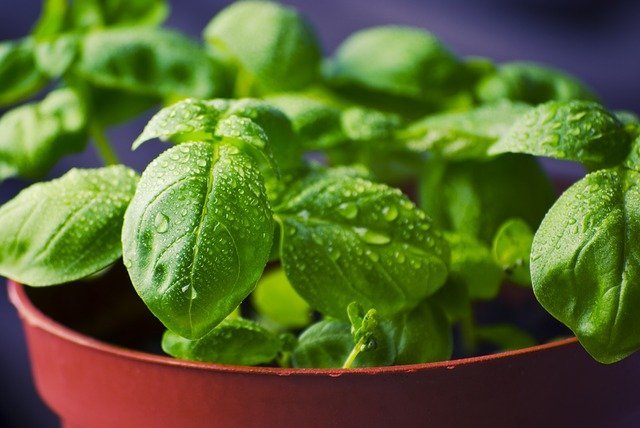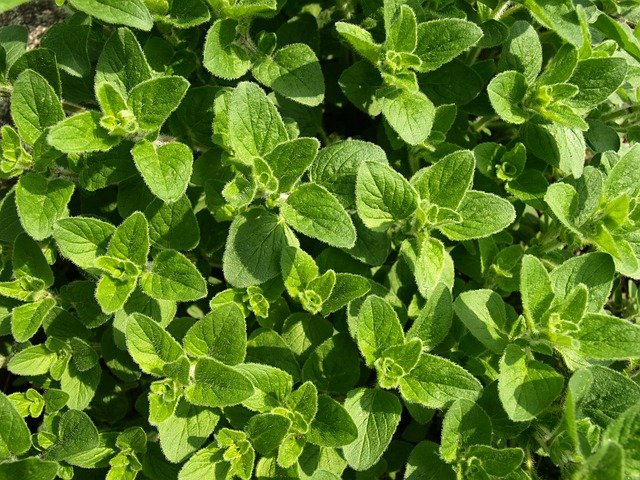People often confuse the two herbs basil and oregano. They look quite similar and you won’t be alone if you get confused between them.
You can differentiate between Basil vs Oregano by carefully looking at the Leaves and Flowers. Further, their taste profile is also quite different.
Let us also look at quick tips on how you can easily differentiate Basil vs Oregano.
Appearance – Basil vs Oregano
a. Stem
Basil
The regular basil has a stem that is light green in color. It is smooth all over. However, there are more than 60 varieties of basil, so the stems vary. Some types of basil like Thai Basil have a purple or brown stem, but the common sweet basil is light green.
Oregano
Oregano has a dark green or brown stem. It is quite hairy, which means that the stem is covered in fine tiny hairs.
b. Leaves
Basil

The common basil has smooth oval leaves that grow up to around 4 inches. They curl downwards. They are dark green in color and release an intense aroma when rubbed.
Oregano

Oregano leaves are ovular and have a pointed end. They grow up to 2 inches. The most common oregano variety has leaves that have fine, tiny hair around the edges.
The Oregano leaves are smaller, flatter, and longer than those of basil.
c. Flowers
Basil
Basil flowers are tiny and tubular in shape. The common basil has white flowers, while the other varieties have flowers that are different in color. There are some varieties of basil that also have pink or purple flowers.
Oregano
Oregano flowers are either pink or light purple in color. Oregano flowers grow in a bunch like a cupola shaped like tiny flowers, unlike the basil flowers that grow single.
d. Size
Basil
Usually, basil grows about 12 to 24 inches in height.
Oregano
Oregano plants also grow up to 12 to 24 inches tall and spread about 18 inches.
Growth requirements – Basil vs Oregano
Basil
Basil is a tropical herb that grows well in a hot climate. It is very sensitive. Basil thrives in moist soil that is not waterlogged. It requires plenty of water and well-drained soil.
Basil requires at least 6 to 8 hours of adequate sunlight every day. Basil is also sensitive to fertilizers when given in high concentration.
Oregano
For oregano, well-drained soil is your best bet. However, it does not need soil as moist as that of basil. Oregano requires much less water than basil.
Over-watering oregano can stunt the growth of the plant and might not survive for long.
Both herbs require a warm environment in order to survive. An indoor temperature above 50F is ideal for both herbs.
Lifespan
Basil
Basil has over 60 varieties. While some varieties are perennial, some are annual. However, basil at large is grown as an annual herb. The regular sweet basil, the one that is most used around the world, is an annual one.
They tend to grow in spring and summer and start flowering towards the end and die during the winter after flowering and going to seed.
Oregano
Very different from basil, oregano is a perennial herb. It has a lifespan of easily more than 4 years. The growth of oregano can be easily controlled if you are growing it indoors if required.
Taste
Basil
Basil has a strong flavor and a sweet taste.
While overall it is described as having a peppery taste, the taste varies quite a lot among the different varieties of basil available. For example, Holy basil has a spicy flavor, while lemon basil has a citrusy taste.
Oregano
Oregano is a very aromatic herb. It is not sweet like basil.
Oregano has a slightly bitter taste with a pungent flavor. The taste is also described as earthy or musty with mint undertones. When consumed in large quantities, oregano can leave an acidic feeling in your mouth.
1) Recipes that use basil
Pesto:
Pesto is a classic dish that uses the full flavor of basil. Freshly grown basil can make a huge difference in the quality of your basil.
Thai chicken:
Thai chicken that uses Thai basil is a delicious dish of oriental cuisine.
2) Recipes that use oregano
Meatballs:
Meatballs use oregano very well, especially dried oregano.
Stuffed bell-pepper:
A classic in Italian cuisine, stuffed bell-peppers are a great recipe for the use of oregano.
3) Recipes that use oregano and basil together
There are not a lot of recipes that use basil and oregano together, as their flavor is slightly contrasting to one another.
Pasta:
Basil and oregano pasta is a great way to use the two herbs together. It is a simple and healthy dish.
Pesto:
A pesto can make use of both basil and oregano together. A pesto focusing on these two herbs can be a flavorful addition to many dishes.
Baked salmon:
A garlic-baked salmon can use basil and oregano in the best way.
Basil and oregano can also be used together for different types of pizzas, pasta, and more.
Note:
An important thing to remember is that both these fresh herbs should be added towards the end of your cook any time that heating is involved.
When any of these herbs are overheated, it turns black and crispy and loses all their flavor. There might be a few exceptions like the Holy basil, which actually releases flavor through heat.
Substitutes: Can you replace basil and oregano with each other in cooking?
While you can replace one herb with the other, it is important to keep in mind that both herbs have very different flavor profiles.
Basil is a mild herb, while oregano has a strong, pungent flavor.
Because of this, it is important to adapt the quantity according to what the recipe calls for.
If you are using oregano as a substitute for basil, you will need to use a lesser amount of oregano than basil. In the same way, if you are using basil in a recipe that calls for oregano, you will need to use more basil than you would have used oregano.
Thyme is considered a substitute for both basil and oregano.
Basil and Oregano: Companion plants?
Basil and oregano should not be grown in the same pot.
Both plants have different watering needs. Basil requires constant water and moist soil, while oregano will not survive in too much water.
If you do want to try companion planting, ensure that you grow together plants that have similar requirements.
Oregano grows well with sage, thyme, rosemary, lavender, and marjoram, while basil pairs well with parsley.
Dried basil vs dried oregano
It is always recommended that you use fresh herbs in your recipes. However, that is not always possible or feasible.
If you harvest a lot of basil, you will need to store it so that it does not go to waste.
A dried herb has a stronger flavor than a fresh herb of the same quantity. For instance, 10 g of dried oregano will have a lot more flavor in it than 10 g of fresh oregano.
For basil, use only half the amount of dried basil as you would fresh basil.
For oregano, the ratio is 3:1 of fresh oregano to dried oregano.
Nutritional profile
Basil and oregano have a wide nutritional profile.
Basil
Basil has 23 calories per 100 g.
It has fewer sugars and no cholesterol. Basil has a lower amount of sodium. It has more Vitamin A and C. The amount of Vitamin C in basil is 6 times higher than that of oregano.
Potassium helps normalize the water level and blood pressure in the body. Basil has 295 mg potassium per 100 g.
The glycemic index is the ranking of carbohydrates in the food that may promote better blood sugar management. The glycemic index of basil is about 70.
Oregano
Overall, Oregano is richer in micronutrients than basil.
Oregano contains more carbs, fats, protein, and fiber, and no cholesterol.
It has more calories than basil. Oregano has about 265 calories per 100 g, which means that the calories in oregano are 11 times higher than basil.
Oregano is also richer in Potassium, Iron, Calcium, Zinc, and Copper. The amount of magnesium and copper is twice as high in oregano as in basil.
Oregano also has a higher vitamin content. It has 30 times more Vitamin E, 4 times more Vitamin B1, and 5 times more Vitamin B2 than basil, as well as a higher amount of Vitamin K, Vitamin B3, and Vitamin B5 and Folate.
Oregano contains more potassium than basil, with 1260 mg potassium per 100 g. The estimated glycemic index of oregano is 14 times lower than basil, which is about 5.
Health benefits
Basil
Basil has strong anti-oxidants with numerous health benefits. They can help reduce the risk of several types of cancer, like lung cancer, skin cancer, liver cancer, or oral cancer.
It contains eugenol which can reduce high blood pressure. It can also help in treating type-2 diabetes. It contains essential oils that can help lower cholesterol, and magnesium which can improve blood flow.
Basil also has anti-inflammatory properties that can help treat diseases that cause inflammation. Basil has anti-oxidants that keep your skin healthy by reducing wrinkling and acne.
Basil leaves have properties that might help in alleviating stress, anxiety, and depression, increase the ability to think, improve sleep, and lower the risk of dementia.
Oregano
Oregano is high in antioxidants that can help stop the growth of cancer cells.
The essential oils in oregano can reduce the number of E.coli bacteria in the gut and help cure diarrhea. It can also help reduce inflammation.
Oregano is rich in zinc which helps improve the health of your hair.
Both herbs, basil, and oregano are very good to use in different recipes and easy to grow in your indoor garden.


